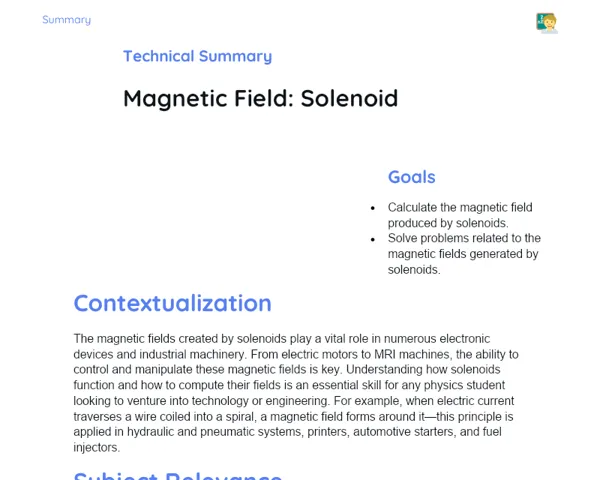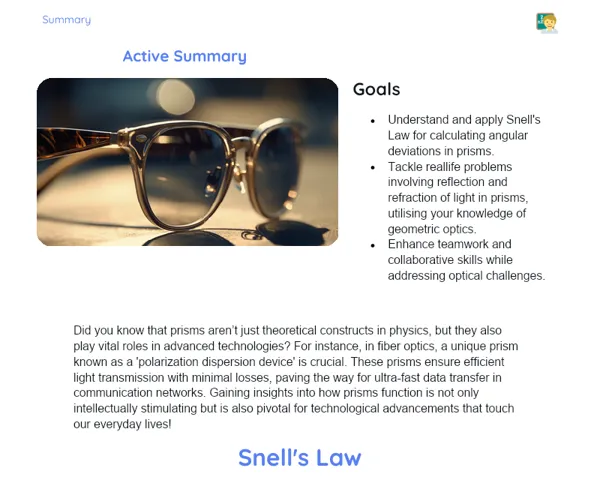Socioemotional Summary Conclusion
Goals
1. Understand that the torque of a force indicates how likely it is to make an object rotate.
2. Calculate torque using the formula: τ = F x d x sin α.
3. Recognize the relevance of torque in our daily lives and its real-world applications.
Contextualization
Imagine trying to open a heavy door with just one finger! Seems impossible, right? But with a proper grasp of torque, it’s actually easier than you think. Torque is vital for understanding how small forces can create significant rotations. 🔄 In our daily activities, whether using a wrench or pedalling a bicycle, we regularly apply the concept of torque. Connecting with this knowledge can streamline our lives and save us from some common frustrations! 😉
Exercising Your Knowledge
Definition of Torque
Torque, often referred to as the moment of force, measures the force that can cause an object to rotate about an axis. The calculation of torque is influenced by the magnitude of the force, the distance between the force's application point and the axis of rotation, and the angle between the force and the lever arm.
-
Torque indicates how a force can cause an object to rotate.
-
It’s essential for understanding how forces lead to rotational movements.
-
It relies on three primary components: force (F), distance (d), and angle (α).
Torque Formula
The formula for calculating torque is τ = F x d x sin α. Here, τ represents torque, F is the applied force, d is the distance from the force's application point to the axis of rotation (lever arm), and α is the angle between the force and the lever arm.
-
The torque formula integrates the applied force, distance to the axis of rotation, and the angle of application.
-
It is crucial for addressing practical challenges involving rotational motion.
-
This formula allows us to calculate the effectiveness of various forces applied at different points.
Units of Measurement and Practical Examples
In the International System of Units (SI), the unit of measurement for torque is Newton-meter (N·m). Everyday examples of torque include opening a door, using screwdrivers, operating levers, and pedalling bicycles. Understanding torque enhances our efficiency in various daily and professional tasks.
-
The standard unit for measuring torque is the Newton-meter (N·m).
-
Torque finds practical applications in everything from doors to tools and bicycles.
-
Understanding torque can boost efficiency and help avoid frustrations in everyday activities.
Key Terms
-
Torque: A measure of the force that can induce the rotation of an object around an axis.
-
Lever Arm: The distance from the point of force application to the axis of rotation.
-
Newton-meter (N·m): The SI unit of torque measurement.
For Reflection
-
How can your knowledge of torque enhance your daily tasks?
-
Think back to a time when you found a practical task frustrating. How could understanding torque have simplified it?
-
In what ways can a grasp of torque and its applications enhance your teamwork and collaboration skills?
Important Conclusions
-
Torque is fundamental to understanding how forces can induce rotational movements in objects.
-
The formula τ = F x d x sin α is crucial for calculating torque and tackling practical problems.
-
Knowledge of torque has numerous applications in our daily lives, from using a screwdriver to pedalling a bicycle.
-
Acknowledging the importance of torque can enhance efficiency in various daily and professional activities.
Impacts on Society
Grasping the concept of torque is vital in today's world, with multiple applications impacting our daily lives and industries. From simply opening a door to working with complex machines, torque plays an essential role in many scenarios. This understanding not only streamlines tasks but also lightens our workload, making daily life smoother and less stressful.
Moreover, mastering torque significantly aids in responsible decision-making and problem-solving. For example, in engineering tasks and machinery maintenance, optimizing the use of torque can help avert accidents and promote safety. This understanding also encourages teamwork, as many torque-related tasks require effective collaboration and communication.
Dealing with Emotions
To manage your emotions while studying torque and its applications, I suggest an exercise based on the RULER method. Start by recognizing how you feel when faced with a torque problem—anxiety, curiosity, or perhaps something else. Identify what triggers this emotion: Is it the complexity of the problem or your eagerness to learn? Name your emotion, be it frustration, excitement, or another feeling. Convey this emotion effectively, perhaps by journaling or discussing it with a friend. Finally, channel your emotions using deep-breathing techniques, short breaks, or by altering your perspective to approach the task more effectively.
Study Tips
-
Craft practical examples from your daily life that involve torque, like opening a door or using a screwdriver. 🎡
-
Form study groups to discuss various torque problems together, helping each other grasp the concept better. 💬
-
Schedule regular breaks while studying and use mindfulness techniques to maintain focus and manage stress. 🧘♂️



